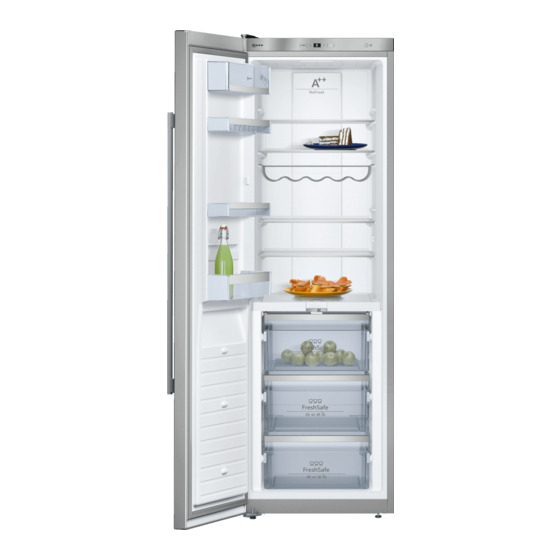
Table of Contents
Advertisement
Quick Links
Advertisement
Table of Contents

Summary of Contents for NEFF KS83 Series
- Page 1 REFRIGERATOR en Instruction for Use KS83..
-
Page 2: Table Of Contents
en Table of Contents Safety and warning information ... 3 Usable capacity ........11 Information concerning disposal ..6 Refrigerator compartment ....11 Scope of delivery ........6 The “cool-fresh” compartment ..12 Installation location ........ 7 Super cooling ........13 Installing appliances Interior fittings ........ -
Page 3: Safety And Warning Information
switch off the appliance and enTable of Contentse n I n s t r u c t i o n f o r U s e ■ Safety and warning pull out the mains plug, information inform customer service. ■ The more refrigerant an Before you switch ON the appliance contains, the larger... - Page 4 Keep plastic parts and the Important information when ■ door seal free of oil and using the appliance grease. Otherwise, parts and Never use electrical ■ door seal will become appliances inside the porous. appliance (e.g. heater, electric Never cover or block the ice maker, etc.).
- Page 5 Children in the household General regulations The appliance is suitable for Keep children away from ■ refrigerating food. packaging and its parts. Danger of suffocation from This appliance is intended for folding cartons and plastic use in the home and the home film! environment.
-
Page 6: Information Concerning Disposal
Warning Information concerning Redundant appliances disposal 1. Pull out the mains plug. 2. Cut off the power cord and discard * Disposal of packaging with the mains plug. The packaging protects your appliance 3. Do not take out the trays from damage during transit. -
Page 7: Installation Location
Installation location Installing appliances next to each other A dry, well ventilated room is suitable as an installation location. The installation Fig. . location should not be exposed to direct When installing two appliances, ensure sunlight and not placed near a heat that the refrigerator is on the left and the source, e.g. -
Page 8: Fitting The Wall Spacer
Fitting the wall spacer Ambient temperature and ventilation Fig. 0 If available: Ambient temperature Fit wall spacers to obtain the indicated energy rating of the appliance. The appliance is designed for a specific A reduced wall gap will not restrict climate class. -
Page 9: Connecting The Appliance
The appliance complies with protection Connecting class I. Connect the appliance to 220– 240 V/50 Hz alternating current via a the appliance correctly installed socket with protective conductor. The socket must be protected After installing the appliance, wait at least by a 10 A to 16 A fuse. -
Page 10: Getting To Know Your Appliance
Controls Getting to know your Fig. " appliance On/Off button Serves to switch the whole appliance on and off. “Super” button refrigerator compartment Switches super cooling on and off. Temperature selection button The required temperature is set with this button. Please fold out the illustrated last page. -
Page 11: Setting The Temperature
Operating tips Alarm function After the appliance has been switched ■ on, it may take several hours until Door alarm the set temperatures have been reached. The door alarm (continuous sound) Do not put any food in the appliance switches on if the appliance door is open beforehand. -
Page 12: The "Cool-Fresh" Compartment
Vegetable container To retain aroma, colour ■ and freshness, pack or cover food Fig. $ well before placing in the appliance. The vegetable container is the optimum This will prevent the transfer storage location for fresh fruit and of flavours and the discolouration vegetables. -
Page 13: Super Cooling
Storage times (at 0 °C) Interior fittings Depending on the initial quality (not all models) Fresh fish, seafood up to 3 days Glass shelves Poultry, meat (boiled/fried) up to 5 days Beef, pork, lamb, sausage up to 7 days Fig. % (cold meat) If required, you can vary the shelves Smoked fish, broccoli... -
Page 14: Defrosting
Take out glass shelves Defrosting Fig. % To do this, pull out shelf, lift at the front Defrosting is actuated automatically. and take out. Take out shelves in the door Fig. & Cleaning the appliance Lift shelves upwards and take out. Removing the container Fig. -
Page 15: Light (Led)
Light (LED) Operating noises Your appliance features a maintenance- Quite normal noises free LED light. Droning These lights may be repaired Motors are running (e.g. refrigerating by customer service or authorised units, fan). technicians only. Bubbling, humming or gurgling noises Refrigerant is flowing through the tubing. -
Page 16: Eliminating Minor Faults Yourself
Eliminating minor faults yourself Before you call customer service: Please check whether you can eliminate the fault yourself based on the following information. Customer service will charge you for advice – even if the appliance is still under guarantee! Fault Possible cause Remedial action Temperature differs greatly... - Page 17 Fault Possible cause Remedial action The “cool-fresh” The standard setting has The temperature in the “cool-fresh” compartment is too warm or been set too high or too low compartment can be set to be 3 steps warmer too cold. (e.g. if there is frost and/or colder, Fig.
-
Page 18: Appliance Self-Test
Appliance self-test Customer service Your appliance features an automatic Your local customer service can be self-test program which shows you found in the telephone directory or in sources of faults which may be repaired the customer-service index. Please by customer service only. provide customer service with the appliance product number (E-Nr.) and production number (FD-Nr.). - Page 19 Alarm Super "...
- Page 20 &...
- Page 23 *8001078427* 8001078427 (9901)












Need help?
Do you have a question about the KS83 Series and is the answer not in the manual?
Questions and answers